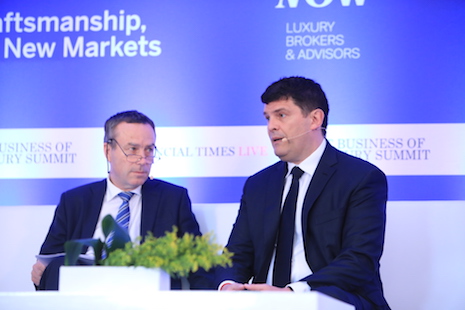LISBON, Portugal – Kering Group’s global performance has been fueled by the reinvention of Gucci, whose success demonstrates how fantastic creativity paired with top-notch execution bolsters market prowess.
During FT Business of Luxury Summit’s opening keynote May 16, Kering’s group managing director spoke to the “hot sauce” that has made this year the most successful for the French luxury goods conglomerate. Although the executive summed up strong performance to consumer loyalty, he explained how Kering’s business model and approach to balancing creativity, data and logistics has gleaned results for its individual brands and as a whole.
“I would say that the world of luxury has been changing," said Jean-Francois Palus, group managing director at Kering Group. "The market is becoming more difficult. The pace of growth has slowed down, and in this environment you need market share.
"In my view, this is something quite new," he said. "Today you need to take market share from the competition and to do so creativity and craftsmanship are obvious. They are absolutely key and they are the drivers of a brand’s success. But, you need to have something more.
"You need to execute well. The reason for [Kering Group’s] outstanding performance and our taking marketing share from the competition is a combination of fantastic creativity and top-notch execution."
Cases at Kering
While in conversation with FT editor Lionel Barber, Mr. Palus stressed the importance of the relationship between a brand’s creative director, the CEO and the merchandizing director.
By asking questions of each, Kering is able to create momentum and an energy that balances the responsibilities, but gleans productivity and worthwhile results.
Showing the necessity of this dynamic, Mr. Palus acknowledged you cannot really speak to market share with a creative director as you can with a CEO and if you discuss a collection’s balance with the merchandizing director, that discussion can influence the designer.
Above all, the three need to be aligned and lucid.

Left to right: FT editor Lionel Barber with Kering Group's Jean-Francios Palus
In the last two years, a successful case study is that of Gucci. Led by the Italian fashion house's “creative universe,” Kering saw its luxury business activities increase by 34 percent for the first quarter of 2017.
Gucci had record growth for the quarter due to the growing enthusiasm for its revived aesthetic under the creative direction of Alessandro Michele. Interest in Gucci resulted in revenue increases of 54 percent, within all regions and product categories, including ready-to-wear and leather goods (see story).
Before being appointed creative director, Mr. Michele had already worked at Gucci for a number of years, and since taking the helm has brought a new vision and aesthetic to the brand.
For Mr. Michele’s Gucci to succeed, there needed to be company-wide alignment, led by Marco Bizzarri, CEO of Gucci, that started with brand image and trickled down to collections, communications, retail concepts and even the pace of deliveries.
While Gucci has been incredibly successful during a transition period, menswear brand Brioni did not see the same stability and strong performance when a new creative director, Justin O'Shea, was brought on to shake things up. Mr. O'Shea, who had no prior design experience, stepped down from his role at Brioni in less than a year's time (see story).
Brioni has yet to appoint Mr. O'Shea's successor.
In this time of creative transition at Brioni, Gianluca Flore announced that his nearly two-year tenure as the brand's CEO would come to an end in February 2017 (see story). In March, Brioni named Fabrizio Malverdi its CEO, looking forward to greater international expansion (see story).

Brioni bespoke illustration
Mr. Palus feels that at some point, Brioni lost its necessary alignment and the faithfulness in brand equity.
Though it has been a challenge, Mr. Palus and Kering has been working to reestablish what Brioni means as a brand, is formalizing a new brand platform and is hopeful it will secure a creative director who embodies the vision in mind, and who will not deviate from Brioni's DNA.
Fashion flexibility
Beyond creative- and business-minded balances, a successful brand must develop a digital presence because everything today moves incredibly fast.
Mr. Palus stressed that there is no harm in looking at other industries for digital inspiration and to learn, as the “aristocratic” mindset that luxury is often beset with is counterproductive.
Luxury’s digital dealings should take a holistic approach and online communications must be aligned with a brand’s image. Digital, which includes social media, allows a brand to create a personal bond with its consumer base, enabled by data, as well as facilitating ecommerce sales.
Digital and consumers’ instant gratification desires have led to the emergence of see-now, buy-now concept. While not all brands willingly embraced the idea, it did nudge Kering brands to reconsider how storefronts are stocked, warehousing and delivery pace and logistics.
Instead of a full collection, or 80 percent, landing in-stores at the start of a season, Kering’s brands stagger drops every two to three weeks. This strategy enables efficient manufacturing planning and sustains consumers’ desire and their sentiment for newness.
"[At Kering,] we think that our industry needs to be a bit less product centric, and to become way more customer centric," Kering’s Mr. Palus said.
"Being customer centric you realize that you need online channels, because when you want to buy a Brioni suit you do not care if you buy it in a Brioni store, a Bergdorf Goodman[-type retailer] or on a Web site," he said. "We provide you with a very seamless experience the moment you browse our channels.
"It is not easy, but we have to do it."
{"ct":"2jcBwkcW\/w0SuW9R\/qXED3PP5iJXsjF4YlKNFcvug4brRHjUbzrgnhgPhI3H77ZClzYPrA+zzrfrDD6tkP3ZTic6lac17Wi9gcUWQnv2PnJCg96mGB6Ik6ZxgXBjTMMadVahJimMNqgTyVT1pqB\/wwpRp8Rxa7LzSiIi12z9UmSfc3hJvllEZn30ybY4ZwaZJu8VhUeaQmM4HnJMq9aCPVVe8kyXMhgQcpCUArdANXaxEKzsa9VL5Wda4+BTWVf76gkmViFu20gg2WFXjUtDQlzKviVrDlLqZxtp26j\/kT8I3nG9sFpsulWncyWjQf7onKlDGMFaG9M2riBr+iaruJMIHpWRYj\/wgxFX1CRXmD+0J4dQ311bHYkIma6oMq80XSSUSN3l67C1K+YEZDqZxHPQwu0PjhAH7qWBhVvKJ138JwcAe1wIbUOHjMvB1Bo0L\/u0IjWHBB+43b7wBm9jUN7nDV3vvzlIc47L56DQibhyr1M39laY\/INGqyL42oLI\/C+L8\/sNoJN57J7u4fw+a8E38HTTZPzzcca4JY1bv7Y3MpN91DjdQ8hHaq3vkE911WYbP0v98KCWX3qocgRKUc\/w\/EoozLt9byuy8eFNdkq8KVbkHcNaKAoA5t4ZO78Te6UEMzERa7rXGWrE7T5ULtd0pLdNV5CFaYiUyAAD5wb5ayU\/VYmnWyjO6HNHtfNbeWRP0XnJaJzsJT4NwVF\/0VIaQ1c1dZWA2\/iVfZqmS6Sob4EFA83giEPpRncxmUPL\/QKfr0qZn0Qi3YzKHzO8CTE0FIBsnB0kCp1h466X5KhXu\/g4CZi4jFXKycxDKB+dHBhVKJBom1mrZBGfjgzcKG1DH0HU2oDNMg9Nc3mWowy1scNOYsrVste8yTA++yYVgzC4OxIRSb4HKJNWLoqOKe0c\/vUD3MPcvLa1prpUTF5HAlBJ3p4eja\/0zplMOzgubJ\/wA7ate6tq\/vtbtIMfCSyBYnRG\/6pg\/6V4tTulmA\/LMT0cZEP1nVk+UfGsekwOc0Dgu+axPNcie3geUVBTc+EDhcbXXErPG\/RNvxH2g6sBhVBlVt6m4ar8v8iFKZN1BkhXYNxE1YKW9PooMJgaR8BxwelonePC39YkWySg16G6DEIyggSLNtqLVLnbvSSdeew+TcZUXgjcMvs2jvyL3S8LEdGaB1RvtQ+o9quFw9Z3xdvf6YbHZ5IvNDJfQ8eJda4s\/kVIe149X4d9oGYyoxrIWEsVi\/d1D6gmjagWqZygiyqTpc1\/nvd11g8siJNOyCIH2deEX238O7hwvIOsoij02DJfwo8q7nHDocwI6Y1klXHMxD6rcLCxaRuFF\/v5DUhtDzfgWH\/x\/7a1hzS7rXouRg0oPwZBKm+mmjtvH3\/Wp1C7tJ2ARo4gjWE979PvOlMBFQJy0qe+Z20LzKp\/X+wupxrEWxwKLKYRV2DiwIsgYkrosf6JTRbvIzL0ATwpAHBf\/xut2vyBcEnmMrm8ZQvBStqWlHhQbopgux0Bip8Or0wNTwC+8Bkb\/Owcu8IVIOEkKQt3G6kePGx1TylovORtnWXpdQtJX92XCIAB6SG+bo2XU8BWmutmjIv3dwiEa5fVAw5pRbiNT07LoyQe1hqagAPDWSpt5Z5EieZaw0YA5adrSLpMCUldp6Jkqyi8DT2UlpA+sWzxyAo0FLe6ASS0H\/1zLMk04FY62c5fe5gvz7VNHsL4GFzwI9xlEdTY3L+IA2azk+GSlAvzll3trOLwLeR1NDrzgrC8QlcrlqSAUg0jtR6kYK67oGFeqWoRAzKyR6ChuL4Xz3PksiWUm+uel\/uByGGkuLk0gN5lgXgxxiinOvMLkKiXy6EGrKRG5vjHRiRWufNdj2OpfMIrXnC67RHFsl3fFr5G0TpAWePV6JdBcF2UrAJlzvnPhIGTtQrauXWmDSPjIS5S8jN9+AYXC+vjMd3rlgq3N\/ALOG20vCChUtXE4K8Ss4s2rSUak09SRjy+n1zY+hUnogqosH6ne71eNI9bvhpjvlB7TduV7kY4bkDaKT\/YHSRv\/N7AtJboVAPTMdAbIaGBbXXHjc81M4Oevo0kv7o\/dzG6rVZY0fehwvDtd87uzDcF3WgYtYwKrO+uPh6Bhh2x7SJg4BHfgzrlRZjnQUkYk4MhktHViZip\/lS2DK2Vd2mBCGQmieiIPUlj47OwoTaVfioBhww0H5UdLyImwxN0gziYcVQelgofGyrRB5xjUnWSERxxXsG4eEaXhpBf3yHaYrX\/ikZhzzWX\/3O0dsJI5XZ3miH68vq43wkfR8IUSazNqk96ihgYe5XeRoggwsncuKYOKj43gMVAVtQ14ujzD5RPrQtTrd4f8s+4QtQkAGR2sI9JGumseGUAw6IOP7la96hq7QWLq99sRTVLNMydWZDdTlQyLjOHXvo5sLSLoTB0FDFtcijdfQLCjF0HgHV7u53HB4iGvwoRQQVvwkVTnpo5R7q0idqo4zv9jUa61oZO6uU0lMNxLsa\/KsR66oIyqy3Kqn++u07wLK8F6Pfsl90JTUJArUEBVxK5q3Xc+8xSP2g\/x9w6wGgnhNo6xpCXX8rwy6hLi6EIAxMB4tfpkH87KVzQdjgU3JZRF3L4AJGJCyEHpKZijFyDb61KUdvVtKK\/9uHk75ACxXf+vG3g5TKOGN\/Pb\/+qUPKZyz2Vj5zLuVnhuGzq5kOZ75oJDA4qXRFPUvJx1cqzniHBH7BeR5GyJD9hBXdc\/sQJnB1h5jYco0DnGa06WvwH9JptXFvTT4BpuWjjmeGk\/SkkHBn0LU3IY9dzwhXDZjIddztBIz6p1HsRwgv4DjDf8vbY4inMCb14xyACf1w2vRq5TQIJGZtnnVvpCGYgFD\/5PkGiLesBj3lWILmujvT1npvaTwjBgdoZYM6Cni8igjoJrL+1hZxvaI27kEfB1Tv9BzHQPwxyzGDcgZDhbmSkAGdWmYcicoI9+RvcI92l17XVKN2PZGEyEdh52JwHH9W6pC8mpXEVXkXydkZsLnyPssLvd90rfpteAuwoOcz0UudVuO6lLX++SthGXKZQEtu8bg6r5P2C\/pymc3EBvXBRghOuXo+DqnuTLf1kp2VT6ojcznmdCjkx4P2IQiPD6AFmScbdJlI1cQ4KgDmq3uLoAE1ptWYc8fpDSvEEP9ZwV\/PVh0qJcN9I2ckAtdzAuqc6L871FfFtlXauJLyDPuwlZClILzWI2wgzVGAGoyWow+FZugKoheRS+C38+C3XVideJeQM0OjAADJgJ4HImLO85+rIgbvMQ\/jz\/d5EQHPIJr4eHX7sRGx6Z8T+P\/Ki+UGjKPSCe1zurmGWdpY4pWZ8hquEvxQP\/yGme6v7+0y5GPC2HjpC8tmhz25wBoTf68FCvjCWrPgaTjb0lEHerRDIHn9nmJ8zdHxK5ch4ulVi3fVXn8grdDq1vZ0kX3jNtaGRxONFPotODCImrcyD+czrFxTEeEGWFvcCf7oft2BSRJDi4hVtCGWDBE87MUEURCF\/ZzgiTZTQ+ib3V2MTwafxvt1GwDJT3KDNtyAZHxs2a6GR9xkxb4iiFpZ8u966wdJgnZxdclcblYav8OzEgpFKRZtlKHBj24N4\/0EkTrYkjO3LymTx\/yweE9t7MczVg4D5IZ+YCRlazBNebsjqNsn\/bClwUYzeoUIdNYaVRpi\/pJId1nHziR7EIdTkRzxHHxxeLaUR8r00EwKOAmwS4ViywmwGTptCYzJncW1xoxIbthveDlZIySC3iIMUoe3iZMVobLhOoOYdx56BzoSCbSh97YSZg3xsukz580+A0THe9NGtVxrD7O0vK8PFGNoQgDNYceJc9Y9Z+n0EFAb3g4qiz80fH+gCc98ExQeHlm\/Nie0Z7qt0QBj+Yg17CQ3\/3faG9aazXzrEIbXOxy1hmXza4rN5IUILJeIp9lw64uAZ5DTVcnCoaXoJRsRcTJ9RUYdS9h\/F1pFhylgoUDzDhRy+MP75gr0UnSbWpbf2w3q1yD7mhu4lx1C6Q8tNzs5p0siS5k9MadX63j576XjwvZHWwRVzx5G5AiN6DjEYsD2tdOLLb0T2BNe8N2NZZbj0b77MHB4\/jQ50QcNOy5yItI38ZVpmT96eRtE32PhYZworzID2pP5+u3Volc0\/FrU4ZiWUJliVR5OYClOR8D4LwcbyywfbfU41a8\/T2N\/UKF0O76rMUacaUr08zSu7oKknLxblh95oGq5EsjLHjLZG5rhTTCZN7+0LYYKtzjyPo2ODbheOSLp5SLVavZnXk76zQFsp3xWHCfhe5eFgok50g+LmCdepmx8i0SoxG6HCuinsOoqbfk91pxeO6wIe1avDxewWKX0HYTIktdRSnVjhWamk68ERxzU1faG7aN04LtXeGGS3ewOUIkR623CHaknnnAzayPxzYQUDqZ5AcYXIusEKQRrKkT5B4O6790WZeYJpn8FsN\/b0I0srSQEn5QYtZa+5qkp1aksv5Z05QAV+gBFGFTsOEi8wWqvgowxu\/uYfC7i3Y9ufTRRwsYw5MpXt\/tCr7fyEMh0UaTvMvAY3BB9RGq8MhbYTFuCUFPUj5hG33IosDEjRhotIfJYuk0cz4BpI8Nn6IIJbDdrYIbbKoFOlmmYBdfRrOMiUHN3BvLw8IeHfgB63z+i18uMuwVTGbhzCydJuerm2V1KoZbiDtbl0JIhJMMk0CtijYowPFT96pZv\/NrTraUtu5Jlz6pRVuDk8OpLzpNdAVFQjoS74ZZniuXmqFnvrF4PP4ZUWuQaHtgfxwlxo1MPymRih7RFO4e3Lyrha0QS0f\/BuqjQKBIoFKoqDN9tpw0eja5wMauuzv+JNzMyALwSC1MJsnzVocHOdT46Kpe9D4+DrXKeyeMqXIBh22QMbOJDiPFU2dRbHQsWju50t+IZz2C2i28tAFgPy885mmr7ferLLFXXReGe2qkYCixSqYI7k\/YWqcFVMjrAgm7Tblh7q4wd1hPo11kkmnVTsEX47jzhTvQ6WnhG0R0W7Wb3XWTnczh0Sd+oW4OMf1kHh9Zlr2CLzyU1qvsa5eRduGLa+vXzg7RA4FVeOimRnqdyVd6FjNFH11B2Ky9+snAJvUVQGAn4tNeuKmMPwp8tKEvC64v5xVr7A6bcANx\/xk1LMHzlnKw0LQvDHe9\/9iwbC9OwpmN82UgJziJASs5+vXzjg8niy79Hrm27tv9nypuPdXtUoyxQfVm2OJ6XTFJ95GKbu9rxAMPq1G4S7ixbNP93lz1j6seI72c7jIYIRtjcKue3LUzs6VvsssYdYhojQWTH+poFLRzOsqmg0ad3K69FgGJxseBCId0xkmw29V8My\/ivOan+i7g8QQNHHcvgP5W6ad5hb2iDcZd0OA0tXebdcClw\/+pKDk9ZdZhuuJC4hKRxOjJWCKezJ3reMB2J9bVpcDeBV9oTxFWzxkqJ7l3mQ6trgCS1zecn8CV7Bc+2p70XW3iXOfFx14Po0PrYy1xYV1m0o\/sLB+Zxjk7LQXkj4cuDhPzWSBVlv35DyO+8BkEdA1Vi8ENhugOVKTSnZsHi8BIxdKOXAqr+D2MsbgaeP5+aJv8xiEWcBJ2wWRodJNFipfSh3CPP0O\/gbWAJYtkGevV46mGw6A4XPsL0yEcfkwKmV6TJffA5M76Nt2hhYkO0ccmq41qb0XgF3awJKS6IPAkg3mEPW0npO6ZGVX9TREdEsAmqmHqn6Dic3Z3XwVnYyHm0SK4ebOhWq0zWFGQJVWQIhr2a6dtIg71dyvP67nWRCjNXeLjbhC9zE8rEzPf7b1cW1qwXrnl3jq+2OTskVMocUKq0FrvOWYegh0mdH0J3cQpUm0EiieB\/EKdsOCi8LG\/4sk+J72iwnkIgm2y2kgAXoL70sDqHc4Rb\/yapB1hNIGAEZOkL6Mjgkcc5K90rmzjY2dXsWG30tR5mUkJXhCsO\/ZB5fD1eZJRj9ejtxVrNhjAhzKL4FbMMGGwTPumQpj2wzdstY8fltm58SJY9ck3ToMYGR5183Yu1d1ZTAy4AkMFf9EAezLfHpKjuF18g3Wou4JqJGe2p\/igPX5iAcjIn6KapOV4ij7QRKRraNcL297uEziGlH7nJluiUQVIsmgjjR+TpVHx7RE9wGveL+uXjf5jF3YsSeSyZJWLaL2BX7rWeDFB0BeqD4E1dHg1oFPgyfRKm2\/C1b+5rgUD7N72lQd\/APUuLA3OfgbZBBrWJf33MgDZmEKGbiL9RTNXgyGgPIfuDf+VJyl6\/MUFVZuIeJLuIwXa2sdMw3l9y+2CU7KpbyY3VpS5vvVkUtWIOfDxa4B5+QSZOBx7kggQYKqq8K\/IT4jAwweCNSt29AUedD5iZnpIEAyuW57vuiuhTCtRgiTiGxL133K\/ezBfeVqEqdhmFZQ2nmkDni60F9\/JCfO8TCVtaA7cN\/I2tqe3+03dg08KZ0L1dDuT02tD06BfT20AXy8lq6m\/9ZG0TAUC59xopuwQ8N247TjYxsn2g\/8PsUndCFsOMnzkgIgmiLTqJqvy4VL2vIPrrPBj2qIaOcD86q2G4zl\/NNMpAnxXmdoR8XxsaUS5jwQK9cl6xbsKtjtLm9LQVhDsrz5OX51+wnSC1JaV9j57lS4c\/HEXVJslql+qipPURKogsCoJ3nBqdsE8kK\/pt6Ic8s19hcPy00X5ZdS\/qpO36j9vzz3FjIdYpQEj4sdHyFWaWy3MRPns3a7BrhX73FBnnA87FSN34s8BYcnsrahkUtsxf5qNNSP6AIbUNE10QBrhacLNmYsPzp8TUsGA+gArcUEtE56wYsS0htFp1NfFQFkny2nZsd7Zn0ADhpGzmjrEUHH4oPZpTk3uQJ2tNWVGRLzw0Stmj1o3E6z2LY1QhxOxbJyOgKmL\/+S3T4+OYb4cXC7KvPPL3bRsnAoRyuK3k4HgMUzQBANgPzmvk4WKrKH+wvRZsoR+EJny4wgzeCFEFVKGTlXdujJahmi7+u3LpjrQ1vbYo6mkYvUU6O55Ksnl+YB\/XA8po7LKfYkSFNatuzNuzAPir5Y6dC6Wkvt\/\/e1wllvoDPAcJNIXUXSaGuhVm91uB0PgVDKojJMJhN1mbo8a++cicpBzNP7YVghcnqNDH+ZCLuqjRT\/jAiYyyum9WLJWwl0EChi4GUIIa5aYd2i7cOKsZhAQy0T0aw2YU2+w3+WmhpxFIu2Z49a0DkMUwphA\/oLXRHkQNENUk3eI9ud0PIM0dXwvnWXZHWPjXq8bGa1tlbLdz7oTn5CYuJYBxep1xcMi415aOiybEP9z9bJO8pIR6uFEdodS3uTYTF5z2XSFXdYXnNOxcVdt9kn9lHTU5QB2Sd\/u0HiiIYWxIMAmTRFWHCq8Jsdn8\/61hnmS2wVhZbeuS5gI6a4\/BBzxbwai6JmA18vgjlcXrBUYcClhboDsnzqL6DYyIFyQ18nGg6fbhnhMll90Hz\/hv1Wg+eNsXnQWecFDGc7j8Kd8tQxyt7OYt6NZjP4S+akwYvK5AYDrCbHjTkFBIKGmdW99k3cmI5I39Ew6AkIj9EyP0ps+bFlDMwivGTCf5eUagyHd5zwl7rcpBOKxkfrUnPjtMoY89juGQGCJ7\/BauwPE2aifYywyAH1NBlckMrxK1mlB+PvRfEkDO03jU0yIsKzjeL5dPI4dlYgT6J4v46XphUuTtZPPUvCu42nm8UvqtTJdmQ69fR0DpXvBCxPALw6y1bS0O0DTsCYRdKaX5c1lgBNubOt4lK\/Z7aPcumNlrG6KkjGXH7W6Jb9dvRLlpbN8hi13zjGSihq1kYJ5k4XGydf8EtT5UPLxCLjDGsDD83WIhvGa34hIlYeeT\/WiNTDHyIOUrmDDGWr3H8uY32XEXNDirRDFqShg\/4Rt0nVw5Fi02W1XGuypJ9yUPok+EdZ1ksgr+uVCAn6J3BJVAzxQuwjLRp9ifiAjnRSgjUy+GH4aT69wQnhKoVRHJbFpVfVCRlyJBEfieP3YNzqwDPItwSWkvrZdvEVirHj56hC2q\/RyRrcxs2e0spn1QXBrAIerYVSk5dJSFS5ozdGhHoQ19p\/mAhGolds3Uo2N2y845Jc+dI256rcPsQ4QN2Pluz3L2nTYVokjPfsXdSolmlclIZ3oGdL7L9bQs\/uyZT8sNFiDupmUf+JlYx1Z1racVXcg9zYboDsyL5m+pHgGB5IDXEd3epDtNHMivCzFCrozVcEUJOB\/h1gJPrKv9D5sgL9LhxEeK4szQi3AGCD0hwetmBzsgzoh1N6Z94LTI0ebAuVl9GDKu6aYVXQRlWK6JG8wcTA1KWbyWgqIdueGxK\/G8tPo75BLjBUjRghNxeu8z833aWUWQDMxUmyhv+ABox+fs71OJGTn04C\/OBqDDBqQO\/6KNu8\/oPuhIncg7\/WDIGpe7Mp1XrmFZlD52dMxUxrsAoH6mLrcw5ZB6vKU5iMHjg1qRhBgc9ao0igXeXu3i9N\/ZpsF7R\/asayaw4ZJiRJaXefJkqYh14rxIKx+M9Wqbtv1QQx0VqroFsr792fjQK7ge45KpbRPbuJejj6mAIUSFmBvFVyPQ9WKEbql5qXV+hTO2umXXY3xLWz\/9QwLqqho2AHi4r1e2kgb9yRR2kXu7xhKEhyx3kVVjHfGeYJPLJauB5SL3nv1f21h9i9jVOQGgnoJOI+C3TVISNfprnhgX2lHmoUmKGz1wJGjHSPPfOpHENqJuewqLX00GJb0QcwzoBrfLaRi4Rykaa51aqekXP0X7RVAkHY4DQcOQPey4i2i9aoYLj29vPU5K1WSeSBbV9L+UXqmYP\/0C517LHtb5bx6xl2egZI97hFs2dUTALNEmcDPf6Cswa9mjPClSXTKY94Dun8DpyEX3zOLSYDoMGUPwgVuX5svUN5idmc+sxfuU8b7x6S3bE7Axfkk3VB3cVnWYcjN2Sr6cmgQg9C2yWFzT0aDXzQpAuqay10xO9sMzi0MWrPrr\/myuUawWK9YkCLqjBf8H\/h9aSIBk5aKv2hP6eIXSUEMzlhOlWiBH2UmLz+bg7rDwoaC5Mn4kU4A1OKmqEGnG9pBGGQSDgKhTSChLDTx1x46HRikgI6e4\/RV9ZpuOVm\/+VYQRMxrC3xUTiS6vXONKgiEdOdzCx32emAxI5NHiTq9ys3IFQ1hQfUZe5meqIKiQfDkkMWWw3ro8egdriStC9\/\/1QoJMu+A326pm061YRxsPgRLeqlYMWE28Xgqs2go0L8UTdp5rd6rrBbQWAwp44l7U7MEFJN9uzcH8Ug+78DN6dIz3iE0ZGGCbIv06JrV\/wboe3yVb7iIFy2B7JjwLiN06strgu2XYVN7O2Ktukkv4bNYM8\/hQFjtbkYSZEUYmcyrLYm8cRxHXJrNTrLY8s0M3ewymWo\/i5t8Y9yH9Oa2dFL0o+MvM34XeO06fzMbByiixcVdfVnSiAMJNgWAH157iK6C004ADnGQezdZ3hM1CzEcrUWwQNPicKTkAZ2UESbQHqC8s52nX4fMJ7DzWNFEtTOA7qR\/zL8Qu6RGkM\/5S\/0hikVUPlHeeRYxeXS06HYvbYnA9C\/bE7BkqTZZYWtjT0Muvq8jZ4NL9yrUb5ml45muariJaNdXAIk6Qql9QAlOsUhi\/KueK4TjxxE66WjcaoX486feQMi6vaxLSzNZ7V0w9D3X\/DJLgQD+JuOdSYE5k4ex8+LD8Ns9hZwPm9yCCVCGxjEnkk5QNE4mWp8WyBO9UPa6wczTfx7NXgYbrAXGzfXOke\/XPgsFyC4LI09IFCHsWIK\/6EuLdakAkGhLIkok\/MbPZvUK\/rjgVKawl89Onms11DI5heFnGrtN7NPsMTH4rzNq\/wzp12QP35K2PJJKzmPzSim\/CfkB199p98rx8mnfPOAZVns+EL8wuZHRJATyMjnX\/5iqGvHINg6UvfwZnWnOfdr7VxKUsV09lUiVHlanbxfCtYwAsOOpp\/lL3Fpp2e8xphuecnqXQFnPlcoZh9QkO\/+p1Xi94J7ptOwDL28NFirLwcKDndiqh\/HqwNUcgimOl9uRrWwx52IE8EdNPCPKq0NCDR43XPUtpQ8m6ZSdg6Wq5WEl07ErLHkc2Fsp9j5D8nGWOOnHdh62RvFUIxVoU+6UucjkzQyKzyxvc+gHG5+ms6AHiy8IA0jrxlCuAWGspLGY41h4w4wa7mc\/KGv8QRUMCNr4N2bQY5h8EMsWoB+2F9\/bAgcBHyuRpHgYCQ6Rnzx1hLPckozAC8MSFv4TxCQc25EtUTYRPLL869Sxfnf5fWh1nnVChLOnMdj5d4pTpwBpvEBLYv1NY+RRZ0xeJ2rNTdHyA7MnOlVjFG97PCArVlqI4cWf4bH9HzVqIhrJa0UHMikbxtKDlQ73KHQXOTezHifBT6rul66jp8uJkAu3+fuUNNHlSeSlCVeZr\/WHVC+MvxiH\/J7r\/LI2D58xTxK1sdMJff2ecbbCb5G305lky71ge\/+MtV\/gLT\/oJHiFIeIe6Z8EyRpPKF+Yyacg2RvhvW9F+G7kfp7NOB7kR4Tc4wYhKK","iv":"27c40182f1d4c7fc1f23150df1eb3332","s":"915faaa9e42fbd23"}

 Kering-owned Gucci's spring/summer 2017 eyewear campaign
Kering-owned Gucci's spring/summer 2017 eyewear campaign